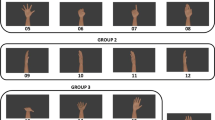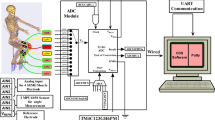Abstract
This current work describes human push recovery data classification using features that are obtained from intrinsic mode functions by performing empirical mode decomposition on different leg joint angles (hip, knee and ankle). Joint angle data were calculated for both open-eyes and closed-eyes subjects. Four kinds of pushes were applied (small, medium, moderately high, high) during the experiment to analyze the recovery mechanism. The classification was performed based on these different kinds of the pushes using deep neural network (DNN), and 89.28 % overall accuracy was achieved. The first classifier was based on artificial neural network on feed-forward back-propagation neural network (FF-BPNN), and second one was based on DNN. The proposed DNN-based classifier has been applied and evaluated on four types of pushes, i.e., small, medium, moderately high, high. The classification accuracy with a success of 88.4 % has been obtained using fivefold cross-validation approach. The analysis of variance has also been conducted to show the statistical significance of results. The corresponding strategies (hip, knee, and ankle) can be utilized once the categories of pushes (small, medium, moderately high, high) were identified accordingly push recovery (Semwal et al. in International conference on control, automation, robotics and embedded systems (CARE), pp 1–6, 2013).









Similar content being viewed by others
References
Semwal VB, BhushanA, Nandi GC (2013) Study of humanoid Push recovery based on experiments. In: International conference on control, automation, robotics and embedded systems (CARE), pp 1–6
Torres C et al (2014) Stable optimal control applied to a cylindrical robotic arm. Neural Comput Appl 24(3–4):937–944
Nilakantan JM et al (2015) Bio-inspired search algorithms to solve robotic assembly line balancing problems. Neural Comput Appl 26:1379–1393. doi:10.1007/s00521-014-1811-x
Semwal VB, Nandi GC (2015) Toward developing a computational model for bipedal push recovery—a brief. Sens J IEEE 15(4):2021–2022
Nandi GC et al (2009) Development of adaptive modular active leg (AMAL) using bipedal robotics technology. Robot Auton Syst 57(6):603–616
Iqbal S, Zang X, Zhu Y, Saad HMAA, Zha J (2015) Nonlinear time-series analysis of different human walking gaits. In: 2015 IEEE international conference on electro/information technology, At Naperville, IL, USA
Semwal VB, Raj M, Nandi GC (2015) Biometric gait identification based on a multilayer perceptron. Robot Auton Syst 65:65–75
Iamsa-at S, Horata P (2013) Handwritten character recognition using histograms of oriented gradient features in deep learning of artificial neural network. In: 2013 international conference on IT convergence and security (ICITCS), pp 1–5
Baptista D, Morgado-Dias F (2013) A survey of artificial neural network training tools. Neural Comput Appl 23(3-4):609–615
Gao S, Zhang Y, Jia K, Lu J, Zhang Y (1999) Single sample face recognition via learning deep supervised auto-encoders. IEEE Trans Inf Forensics Secur PP(99):1
Semwal VB et al (2013) Biped model based on human gait pattern parameters for sagittal plane movement. In: IEEE international conference on control, automation, robotics and embedded systems (CARE)
Semwal VB et al (2015) Biologically-inspired push recovery capable bipedal locomotion modeling through hybrid automata. Robot Auton Syst 70:181–190
Mao W, Kim J-J, Lee J-J (2009) Continuous steps toward humanoid push recovery. Automation and logistics, 2009. In: IEEE international conference on ICAL’09, pp 7–12
Semwal VB, Chakraborty P, Nandi GC (2015) Less computationally intensive fuzzy logic (type-1)-based controller for humanoid push recovery. Robot Auton Syst 63:122–135
Chowdhury S, Verma B, Stockwell D (2015) A novel texture feature based multiple classifier technique for roadside vegetation classification. Expert Syst Appl 42(12):5047–5055
Iqbala S, Zang X-Z, Zhu Y-H, Bie D-Y, Wang X-L, Zhao J (2015) Nonlinear time-series analysis of human gaits in aging and Parkinson’s disease. In: 2015 international conference on mechanics and control engineering (MCE 2015)
Zhou C et al (2013) Backward swimming gaits for a carangiform robotic fish. Neural Comput Appl 23(7–8):2015–2021
Lin L, Hongbing J (2009) Signal feature extraction based on an improved EMD method. Measurement 42(5):796–803
Ibrahim RK et al (2008) Gait pattern classification using compact features extracted from intrinsic mode functions. In: Engineering in Medicine and Biology Society, 2008. EMBS 2008. 30th annual IEEE international conference
Ben X, Zhang P, Yan R, Yang M, Ge G (2015) Gait recognition and micro-expression recognition based on maximum margin projection with tensor representation. Neural Comput Appl. doi:10.1007/s00521-015-2031-8
Yildirim Ş, Eski İ, Polat Y (2013) Design of adaptive neural predictor for failure analysis on hip and knee joints of humans. Neural Comput Appl 23(1):73–87
Kim S-Y, Yang L, Park IJ, Kim EJ, Park MS, You SH, Kim Y-H, Ko H-Y, Shin Y-I (2015) Effects of innovative WALKBOT robotic-assisted locomotor training on balance and gait recovery in hemiparetic stroke: a prospective, randomized, experimenter blinded case control study with a four-week follow-up. IEEE Trans Neural Syst Rehabil Eng 23(4):636–642
Procházka A et al (2014) Discrimination of axonal neuropathy using sensitivity and specificity statistical measures. Neural Comput Appl 25(6):1349–1358
Mao W, Qin G, Lee J-J (2009) Humanoid push recovery strategy for unknown input forces. In: Mechatronics and automation, 2009. International conference on ICMA 2009, pp 1904–1909
Tang Z, Er MJ, Chien C-J (2008) Analysis of human gait using an inverted pendulum model. In: IEEE international conference on fuzzy systems, 2008 (IEEE world congress on computational intelligence), pp 1174–1178
Li Y, Tong S, Li T (2013) Adaptive fuzzy output feedback control for a single-link flexible robot manipulator driven DC motor via backstepping. Nonlinear Anal Real World Appl 14(1):483–494
Sorao K, Murakami T, Ohnishi K (1997) A unified approach to ZMP and gravity center control in biped dynamic stable walking. In: Final program and abstracts. IEEE/ASME international conference on advanced intelligent mechatronics ’97, pp 112
Kankal M, Yüksek Ö (2014) Artificial neural network for estimation of harbor oscillation in a cargo harbor basin. Neural Comput Appl 25(1):95–103
Acknowledgments
The authors would like to thank all the research scholars, M.Tech. students and technical staffs for their comments and suggestions. At the same time, our sincere thanks to IIIT, Allahabad, for providing us all the necessary facilities for research.
Author information
Authors and Affiliations
Corresponding author
Additional information
An erratum to this article is available at http://dx.doi.org/10.1007/s00521-017-3029-1.
Rights and permissions
About this article
Cite this article
Semwal, V.B., Mondal, K. & Nandi, G.C. Robust and accurate feature selection for humanoid push recovery and classification: deep learning approach. Neural Comput & Applic 28, 565–574 (2017). https://doi.org/10.1007/s00521-015-2089-3
Received:
Accepted:
Published:
Issue Date:
DOI: https://doi.org/10.1007/s00521-015-2089-3




